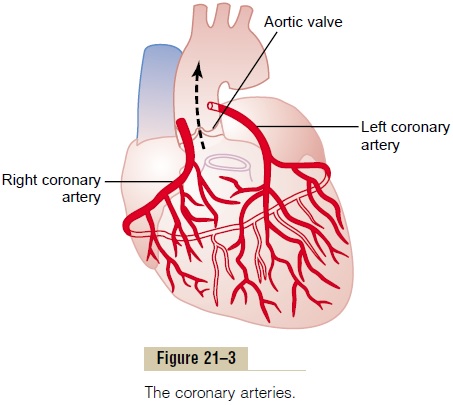Chapter: Medical Physiology: Muscle Blood Flow and Cardiac Output During Exercise; the Coronary Circulation and schemic Heart Disease
Surgical Treatment of Coronary Disease
Surgical Treatment of Coronary Disease
Aortic-Coronary Bypass Surgery. In many patients withcoronary ischemia, the constricted areas of the coro-nary arteries are located at only a few discrete points blocked by atherosclerotic disease, and the coronary vessels elsewhere are normal or almost normal. A sur-gical procedure was developed in the 1960s, called aortic-coronary bypass, for removing a section of asubcutaneous vein from an arm or leg and then graft-ing this vein from the root of the aorta to the side of a peripheral coronary artery beyond the atheroscle-rotic blockage point. One to five such grafts are usually performed, each of which supplies a peripheral coro-nary artery beyond a block.
Anginal pain is relieved in most patients. Also, in patients whose hearts have not become too severely damaged before the operation, the coronary bypass procedure may provide the patient with normal sur-vival expectation. Conversely, if the heart has already been severely damaged, the bypass procedure is likely to be of little value.
Coronary Angioplasty. Since the 1980s, a procedure hasbeen used to open partially blocked coronary vessels before they become totally occluded. This procedure, called coronary artery angioplasty, is the following: A small balloon-tipped catheter, about 1 millimeter in diameter, is passed under radiographic guidance into the coronary system and pushed through the partially occluded artery until the balloon portion of the catheter straddles the partially occluded point. Then the balloon is inflated with high pressure, which markedly stretches the diseased artery. After this pro-cedure is performed, the blood flow through the vessel often increases threefold to fourfold, and more than three quarters of the patients who undergo the proce-dure are relieved of the coronary ischemic symptoms for at least several years, although many of the patients still eventually require coronary bypass surgery.
Still newer procedures for opening atherosclerotic coronary arteries are constantly in experimental development. One of these employs a laser beam from the tip of a coronary artery catheter aimed at the atherosclerotic lesion. The laser literally dissolves the lesion without substantially damaging the rest of the arterial wall.
Another development has been a minute metal “sleeve” placed inside a coronary artery dilated by angioplasty to hold the artery open, thus preventing its restenosis.


Related Topics